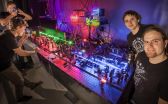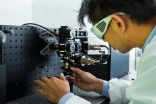New genetic test will improve biosecurity of honey bees around the globe
The test uses 95 genetic mutations that distinguish between African and European honey bees
2015-04-22
(Press-News.org) TORONTO, April 22, 2015 -- A genetic test that can prevent 'killer' bees from spreading around the world has been created in a research effort led by University of Sydney scholars jointly with York University scientists.
"Our genetic test is highly accurate and considerably more sophisticated than the old tests that have a high tendency to misclassify hybrid bees," says Professor Amro Zayed in the department of Biology, Faculty of Science.
Africanized honeybees are highly aggressive and very difficult to manage relative to European honeybees used by Canadian and Australian beekeepers. The international trade in honeybees is restricted, due in part to bans on import of queens from countries such as the United States, where Africanized honeybees are present.
"Having a tool that can identify desirable and undesirable bee subspecies will be of value to breeding and conservation programs throughout the world," says lead author of the study, Nadine Chapman, in the School of Biological Sciences, University of Sydney. "Pollination of crops by honeybees adds many billions of dollars to the world economy, so any strategy that can prevent losses is an important contribution to food security."
The test uses 95 genetic mutations that distinguish between African and European honey bees. "We picked these mutations from a database of over 12 million mutations found in honey bees that we discovered here at York University," says co-author of the study, Brock Harpur, a doctoral student in the Department of Biology.
"The Canadian Food Inspection Agency is very concerned about the accidental importation of Africanized honey bees among bee imports from the United States, and we are very proud to be able to translate our pure research on honey bee genetics to help develop a test that can make bee imports safer," adds Zayed.
The international study, A SNP test to identify Africanized honeybees via proportion of 'African' ancestry, which also included researchers from the US Department of Agriculture and the Agricultural Research Council in South Africa, was published in Molecular Ecology Resources, April 20.
INFORMATION:
York University is helping to shape the global thinkers and thinking that will define tomorrow. York U's unwavering commitment to excellence reflects a rich diversity of perspectives and a strong sense of social responsibility that sets us apart. A York U degree empowers graduates to thrive in the world and achieve their life goals through a rigorous academic foundation balanced by real-world experiential education. As a globally recognized research centre. York U is fully engaged in the critical discussions that lead to innovative solutions to the most pressing local and global social challenges. York U's 11 faculties and 25 research centres are thinking bigger, broader and more globally, partnering with 280 leading universities worldwide. York U's community is strong ? 55,000 students, 7,000 faculty and staff, and more than 275,000 alumni.
Media Contact: Gloria Suhasini, York University Media Relations, 416 736 2100 ext. 22094, suhasini@yorku.ca
ELSE PRESS RELEASES FROM THIS DATE:
2015-04-22
In the most comprehensive study ever on the impact of smoking on cardiovascular disease in older people, epidemiologist Dr. Ute Mons from the German Cancer Research Center (Deutsches Krebsforschungszentrum, DKFZ) analyzed 25 individual studies, compiling data from over half a million individuals age 60 and older.
Twice as many smokers die from cardiovascular disease than life-long non-smokers do. The increase in risk depends on the number of cigarettes that a person has smoked in his or her lifetime. After one quits smoking, this risk continues to decrease. On average, ...
2015-04-22
In the quantum world of light, being distinguishable means staying lonely. Only those photons that are indistinguishable can wind up in a pair, through what is called Hong-Ou-Mandel interference. This subtle quantum effect has been successfully imaged for the first time by two doctoral students from the Faculty of Physics at the University of Warsaw.
Physicists have long known that photons can become bunched together. However, technological limitations have prevented the phenomenon from actually being observed directly. Only recently has this feat been achieved by two ...
2015-04-22
Bethesda, MD, April 20, 2015: The Association for Molecular Pathology (AMP), the premier global, non-profit organization serving molecular diagnostic professionals, today published a special article in The Journal of Molecular Diagnostics titled, "Do Circulating Tumor Cells, Exosomes, and Circulating Tumor Nucleic Acids Have Clinical Utility?" The report provides a thorough overview of research to-date on the minimally invasive "liquid biopsy" approaches to cancer diagnostics.
"As a group of molecular diagnostic experts, we were intrigued and excited by the emerging ...
2015-04-22
Hasbro Children's Hospital study finds link between adverse childhood experiences and pediatric asthma
Children who experience violence, substance abuse at home
report significantly higher rates of asthma
PROVIDENCE, R.I. - Robyn Wing, M.D., an emergency medicine physician at Hasbro Children's Hospital, recently led a study that found children who were exposed to an adverse childhood experience (ACE) were 28 percent more likely to develop asthma. The rate of asthma occurrence further increased in children with each additional ACE exposure. The study, recently published ...
2015-04-22
Scientists have for the first time captured live images of the process of taste sensation on the tongue.
The international team imaged single cells on the tongue of a mouse with a specially designed microscope system.
"We've watched live taste cells capture and process molecules with different tastes," said biomedical engineer Dr Steve Lee, from The Australian National University (ANU).
There are more than 2,000 taste buds on the human tongue, which can distinguish at least five tastes: salty, sweet, sour, bitter and umami.
However the relationship between the ...
2015-04-22
Rather than slowing down, ants speed up in response to a higher density of traffic on their trails, according to new research published in Springer's journal The Science of Nature - Naturwissenschaften. When the researchers increased the supply of food by leaving food next to the trail, ants accelerated their speed by 50 percent. This was despite more than double the density of traffic.
When food increases in supply, more forager ants are sent out to carry it back to the nest. With this increase in ant density, the number of encounters between outbound and incoming individuals ...
2015-04-22
The ability of materials to conduct heat is a concept that we are all familiar with from everyday life. The modern story of thermal transport dates back to 1822 when the brilliant French physicist Jean-Baptiste Joseph Fourier published his book "Théorie analytique de la chaleur" (The Analytic Theory of Heat), which became a corner stone of heat transport. He pointed out that the thermal conductivity, i.e., ratio of the heat flux to the temperature gradient is an intrinsic property of the material itself.
The advent of nanotechnology, where the rules of classical ...
2015-04-22
Scientists at The University of Manchester have made an important finding that could help develop an early test for kidney disease.
Dr Rachel Lennon from the Wellcome Trust Centre for Cell-Matrix Research has been studying why some people are more susceptible to kidney disease because of their race and gender.
She explains: "It's well known that impaired kidney function is more common in Afro-Caribbean individuals compared to those from a Caucasian background, and in men compared to women. However, the reasons for the difference in susceptibility are only just being ...
2015-04-22
This news release is available in German.
The size of the neonatal skull is large relative to the dimensions of the birth canal in the female pelvis. This is the reason why childbirth is slower and more difficult in humans than in most other primates. Scientists from the Universities of Oslo and Vienna, identified adaptations in the morphology of the human body, which were unknown so far. The results of this new study appeared in the current edition of PNAS.
Upright walking and difficult birth
In hominids, upright walking evolved 4-5 million years ago. The ...
2015-04-22
Is it possible to prevent mental health problems in higher education students? The answer is "yes" according to a team of psychologists from Loyola University Chicago who conducted a careful, systematic review of 103 universal interventions involving over 10,000 students enrolled in 2- and 4-year colleges and universities and graduate programs. The findings appear in the May 2015 issue of Prevention Science, published by Springer.
Researchers indicated that universal prevention interventions - that is, programs targeting general students, not just students who are at ...
LAST 30 PRESS RELEASES:
[Press-News.org] New genetic test will improve biosecurity of honey bees around the globe
The test uses 95 genetic mutations that distinguish between African and European honey bees



